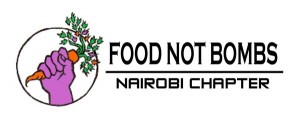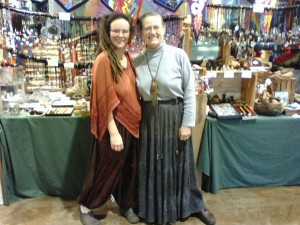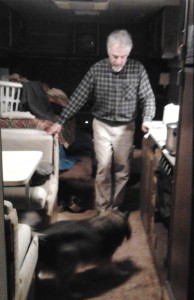On Conflict and Consensus on Sale for 1/2 OFF During August and September, 2013!
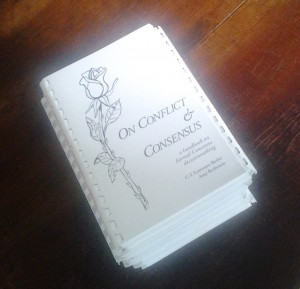 If you would like to have multiple copies of C.T. Lawrence Butler’s On Conflict and Consensus for your group, now is your chance to jump in at a more affordable rate!
If you would like to have multiple copies of C.T. Lawrence Butler’s On Conflict and Consensus for your group, now is your chance to jump in at a more affordable rate!
2012 was the 25th anniversary of this elegant text on having egalitarian, horizontal meetings. So far, print copy sales have well passed the 10,000 mark.
Fiopa Consensus Collective and Food Not Bombs Publishing are offering the seminal work in deep democracy for half price during August and September, 2013.
The usual cost is $15 per copy. This sale’s 1/2 off discount begins at 5 copies, designed to help groups and individuals who want to spread the joy by gifting copies to friends!
Do you have the most recent printing? The current printing will say, “Third Edition—Thirteenth Printing,” on the License and Attributions page. If your group is working from an earlier edition, this is a good chance to get current.
Here are discount prices for On Conflict and Consensus, with shipping/handling estimates:
 1 copy $12.50 plus $3 s/h $15.50 total
1 copy $12.50 plus $3 s/h $15.50 total
5 copies $31.25 plus #4.75 s/h $36 total
10 copies $62.50 plus $6.50 s/h $69 total
20 copies $125 plus $12 s/h $137 total
50 copies $312.50 plus $20.50 s/h $333 total
For exact shipping and handling costs, call 301-586-2560 or email us at fiopa@consensus.net.
Are you aware of C.T.’s latest book, Consensus for Cities? It details how to practice consensus in groups of up to 100,000 people, using an affinity group structure.
Consensus for Cities Discounts:
1 copy $20 plus $3 s/h $23 total
5 copies $50 plus #4 s/h $54 total
10 copies $100 plus $6 s/h $106 total
20 copies $200 plus $12 s/h $212 total
50 copies $500 plus $20 s/h $520 total
Pay by check (made out to “C.T. Lawrence Butler”) or use Paypal, via C.T.’s www.consensus.net site.
What about Value-Based Consensus Workshops, Facilitation and Mediation?
C.T. is available for meeting and retreat facilitation and mediation for group conflicts. Contact us at fiopa@consensus.net to discuss your needs.
At this time we’re limiting our consensus trainings to extended immersions. We are searching for groups that are interested in working with us to learn Value-Based Consensus in a long-term process. Stay tuned for updates on future workshop offerings!
Subscribe to this blog's RSS feed
Protected: Fiopa, formerly Heathcote Earthings, LLC. Looking for Storefront
A Well-Fed Kenya: Food and Photojournalism
 Some stories enter my bones and don’t leave. The story of Nairobi Food Not Bombs is in my marrow and vibrating, refusing to be ignored.
Some stories enter my bones and don’t leave. The story of Nairobi Food Not Bombs is in my marrow and vibrating, refusing to be ignored.
As C.T.’s partner, I’m a witness to the daily news feed of Food Not Bombs arrests and court cases, mostly here in the U.S. In addition, he gets a steady stream of calls all day, mostly people asking advice on consensus and also starting a Food Not Bombs.
One such FNB startup was germinated from C.T.’s trip to Nairobi, Kenya, in 2007. He was there to teach consensus at the IndyMedia Convergence, in advance of the World Social Forum.
IndyMedia is an amazing case study in do-it-yourself journalism, personal and collective empowerment. IMC “converges” at the site of each World Social Forum, a week or so before the WSF begins, to teach grassroots journalism to non-corporate press from all over the world.
The convergences are temporary Intentional Communities that operate by consensus. Workshops teach would be journalists from Africa, South and Central America, Europe and the U.S. in street-level skills like building radios and transmitters out of materials available where they live.
At the Nairobi convergence, C.T. taught consensus and also pulled a hidden skill out of his hat—He taught IMC participants how to build a silkscreen press! This knowledge came from his early days of battling

C.T. teaches IMC journalists how to build and use a 3-color silkscreen press to generate fliers, books, posters, t-shirts, etc.
Seabrook Nuclear Power Plant, starting the first FNB collective, the start of ACTUP, etc.
The convergences are meetings of very different cultures. In Nairobi, C.T. was the “old guy.” While the Northerners (Europeans and Americans) gave him little rank and dismissed his efforts to teach, Africans sought him out and revered him as the elder in the group.
One such new friend erased C.T.’s name from a community chore chart and wrote his own in its place. “In my culture, elders do not do the dishes,” He said.
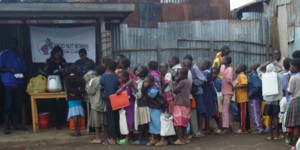 Douglas Rori, a convergence participant who was local to Nairobi, was so taken by C.T.’s stories of Food Not Bombs that he started a Nairobi chapter.
Douglas Rori, a convergence participant who was local to Nairobi, was so taken by C.T.’s stories of Food Not Bombs that he started a Nairobi chapter.
A Totally Different Ballgame
But unlike the twentysomethings who start chapters in their Midwestern college towns or face up against the police in Tampa, Florida, Doug and his Nairobi compatriots couldn’t just show up in the town square or public park with a table and pots of yummy vegan soup.
That’s a recipe for a food riot.
The hunger issue is not a minority issue there. Public feedings such as FNB is famous for the world over would put Doug and other volunteers at physical risk. Plus, with their food stolen, they would not complete their goal of serving the large population of street kids, mostly orphaned in the AIDS epidemic.
Sewing in the IndyMedia Thread
This is where the story gets dramatic in order to prevent drama.
Doug and other young Kenyan activists had the direct experience of how empowering it is to learn tools for telling personal and local stories; to be an alternative to the corporate press party line.
And they had learned filmmaking, photography and journalism in that way. Doug decided to disguise their feedings by offering journalism workshops to the homeless kids.
They chose enclosed courtyards and indoor spaces and spread the word about their workshops. As you can see by the photos, people of all ages came to learn.
And meals were included!
To keep this innovative project going, Doug has formed an NGO, A Well-Fed Kenya, in partnership with A Well-Fed World. This status enables him to operate and seeking funding on an ongoing basis.
Even with NGO status, life is still touch and go for Doug. An IndyMedia colleague was gunned down a few months ago in one of the ghettos, probably an assassination. Doug himself struggles to keep a roof over his own head as he does this important work.
To fund his project and stability for the coming months, we have collaborated with him on an Indiegogo campaign. Please
CLICK HERE TO VISIT OUR CAMPAIGN PAGE,
make whatever contribution you can, and tell your friends Doug’s amazing story! Let’s pull together to keep this project going in the ghettos of Nairobi!
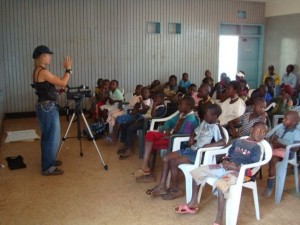 We are starting out with some popular perks from our previous Indiegogo campaign, Food Not Bombs t-shirts and copies of C.T.’s books, On Conflict and Consensus and Consensus for Cities.
We are starting out with some popular perks from our previous Indiegogo campaign, Food Not Bombs t-shirts and copies of C.T.’s books, On Conflict and Consensus and Consensus for Cities.
Doug is also making contact with some fair trade crafts cooperatives and exporters in Nairobi who may be willing to donate some of their jewelry and other crafts as perks for the campaign. So watch for additional perks!!!
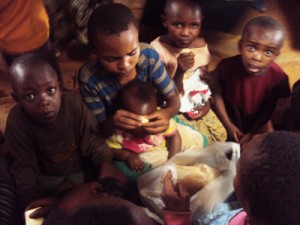 How can you get involved? Certainly, donating whatever you can is a huge start. Are you willing to join our campaign team and use Indiegogo share tools and social media to spread the word? Reaching out to people who don’t already know me, C.T. or Doug Rori is a great help.
How can you get involved? Certainly, donating whatever you can is a huge start. Are you willing to join our campaign team and use Indiegogo share tools and social media to spread the word? Reaching out to people who don’t already know me, C.T. or Doug Rori is a great help.
What ideas do you have for getting the word out about this impactful project?
If you’re in the D.C. region, C.T. and I can schedule a House Party with you. We can supply a slide show, talk about the project with friends you invite, and seek donations. Contact us at fiopa@consensus.net today to make arrangements!
Our main goals for now are to share this amazing story of risk, caring and daring and to get folks to visit our campaign page and donate. We must keep this work going!
When visiting the campaign site, do take the time to go through the photo gallery picture by picture. The interest of the kids in learning from Doug and his friends is amazing. You will understand from the numbers of people who attend that his offering is relevant and is making a difference.
What can you give today?
If This Is Evolution, What’s Next?
 This controversy came across my screen this morning. Dr. Pepper is getting lots of free advertising from creationists who object to the soda’s variation on the March of Progress image. HERE is a fun site that collects a lot of spoof variants that, like most humor, are more honest in my opinion!
This controversy came across my screen this morning. Dr. Pepper is getting lots of free advertising from creationists who object to the soda’s variation on the March of Progress image. HERE is a fun site that collects a lot of spoof variants that, like most humor, are more honest in my opinion!
Of course, I had my first impulse that I must go out and get a Dr. Pepper, to quickly align myself on the side of my beliefs. Then I remembered my other beliefs—especially the one where I believe that putting such crap in my body is not a sign of progress, intelligence, or anything to wear proudly, such as on a red t-shirt, in an ocean of red t-shirts assembled to celebrate the individuality of Dr. Pepper drinkers.
What should the next image on the Dr. Pepper evolution look like? Someone keeled over with a stomach ulcer?
I’ve “evolved” to the point where I partake of a carbonated beverage probably three or four times per year. And I must say, when I go there, I like a Dr. Pepper. But at some point I heard that carbonated beverages in general inhibit the absorption of nutrients. So I tend to just skip them, or think of them as a forbidden pleasure.
I cut and paste this entire post from the hubpages article, What’s in My Food: Dr. Pepper Ingredients Explained:
Reading the ingredient list on your food label and knowing what they are, are two different things. For example: Do you know what the ingredients BHT, partially hydrogenated soybean oil, blue 1, and phosphoric acid are? Well you should, since you are consuming them on a daily basis. One’s use is banned in restaurants. Another is mined from the earth. And the Other two are made from petroleum.
Can you imagine what these ingredients are doing to your body? Well don’t imagine. Know. Educate yourself. Read on to learn exactly what your food is made of, and what it’s doing to your health.
In all products, ingredients must be listed according to their relative weight. The listing of each ingredient is in a descending order of predominance.
Dr Pepper ingredients are: Carbonated water, high fructose corn syrup, caramel color, phosphoric acid, natural and artificial flavors, sodium benzoate (preservative), caffeine.

1. Carbonated Water: Plain water into which carbon dioxide gas has been dissolved.
Health effects: Linked to tooth decay. May reduce fertility. Suspected teratogen (any agent that interferes with normal embryonic development).
2. High fructose corn syrup: Corn derived sweetener. Corn starch is processed to corn syrup and then treated with enzymes to convert glucose in fructose.
Health Effects: Excess may increase risk of tooth decay, abnormal weight gain, kidney stones, gout, kidney stones, colon cancer, and diabetes. Large amounts have caused tumors in mice. In 2005, some U.S. manufactured high fructose corn syrup was found to contain trace amounts of mercury.
3. Caramel Color: Brown food coloring and flavoring made by heating a sugar, usually corn syrup. May be processed with ammonia and sulfur to intensify color.
Health effects: May contain ammonium compounds. May affect stomach (gastrointestinal problems), liver, and cause hyperactivity. Caramel color produced with ammonia has been associated with blood toxicity in animals. Associated with reduced white cells and lymphocyte counts.
4. Phosphoric Acid: A colorless, odorless solution made from phosphate rock (not a food).
Health effects: May lead to calcium loss in bones and tooth erosion. Eye, skin, throat, nose, and respiratory irritant. Can cause osteoporosis. Linked to kidney damage and kidney stones.
*A corrosive, used to remove rust.
5. Natural flavors: Any flavor not chemically derived. Obtained by physical processes from plants or animals. Made to provide flavor to a food rather than nutritional value. May contain MSG.
Health effects: Unknown. Different foods use different natural flavors and processes. Naturally derived ingredients may be altered, rendered unsafe. It should be noted that the use of the word “natural flavors” is often used to mask the use of harmful, naturally derived flavors.
6. Artificial flavors: A synthetic mixture not found in nature, designed to mimic a natural flavor. May contain MSG. Over 1,700 artificial flavors are approved by the FDA.
Health effects: Unknown. Companies are not required to identify the various synthetic mixtures (1,700 to date) used in foods, requiring only that they be listed under the umbrella of the “artificial flavors” listing. Some individuals are sensitive to artificial flavors, experiencing headaches, nausea, and drowsiness, among other symptoms.
Artificial flavors sample list: benzyl isobutyrate, ethyl acetate, ethyl methylphenylglycidate (petroleum derivative), methyl benzoate (petroleum derivative), hydroxyphenyl-2-butanone. An artificial flavor may be made up of any number of synthetic chemicals.
7. Sodium benzoate: Used as a preservative. It is the sodium salt of Benzoic acid. Benzoic acid is synthesized commercially from toluene. Toluene is produced in the gasoline making process and the making of coke (carbon fuel produced by distillation of coal) from coal. Therefore, sodium benzoate is a petroleum derivative.
Health effects: Asthma, hives, hay fever, mouth irritation, and other allergic reactions. Neurotoxicity and brain damage; Linked to hyperactivity and decreased intellect in children. May cause DNA damage, leading to neurodegenerative diseases such as Alzheimer’s, and Parkinson’s.
Benzene, a known cancer-causing agent, can form in soft drinks when sodium benzoate and ascorbic acid (vitamin c, commonly added to fortify soft drinks) are present.
8. Caffeine: A bitter, white crystalline xanthine alkaloid that is a psychoactive stimulant drug.
Health effects: Psychoactive, addictive. May cause headaches/migraines, heart disease, depression. Causes birth defects in rats. Can cross the placental barrier. Inhibits fetal growth. Women who consume the amount of caffeine in one and a half to three cups of coffee may nearly double their risk of miscarriage.
Now you know the facts. You know what you are consuming, and can make an informed decision.
Owning Our Stories: Building a Silkscreen Press in Nairobi
 It’s always a good day when I wake up to surprise jpegs in my inbox. If you’ve kept up with Hippie Chick Diaries for any time, you know that photos are often the seeds of posts.
It’s always a good day when I wake up to surprise jpegs in my inbox. If you’ve kept up with Hippie Chick Diaries for any time, you know that photos are often the seeds of posts.
Here we see my partner, C.T. Butler, in Nairobi, Kenya, teaching a workshop in how to build a three color silkscreen press.
It was 2007 and C.T. was attending the IndyMedia Convergence in advance of the World Social Forum in Nairobi. When there’s a World Social Forum, 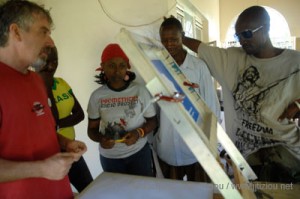 IndyMedia holds a convergence at the location, for a week or so before the event, teaching independent journalists and activists from around the world how to get their stories out using materials at hand. For example, workshops include building radios and transmitters from locally available materials.
IndyMedia holds a convergence at the location, for a week or so before the event, teaching independent journalists and activists from around the world how to get their stories out using materials at hand. For example, workshops include building radios and transmitters from locally available materials.
When their training is done, the journalists and activists are a well-bonded collective that then covers the World Social Forum.
C.T. attended the Nairobi convergence at the invitation of IndyMedia (aka IMC). C.T. is cofounder of the movement Food Not Bombs. The two groups have many cross connections and cross pollinations. Like Food Not Bombs before it, IndyMedia is leaderless, focused on local groups, horizontal in structure, consensus-based, etc.
C.T.’s primary focus was teaching consensus to convergence participants, but his experience in the early days of both FNB and IMC taught him do-it-yourself skills like building a silkscreen press by hand. C.T. often built and used makeshift silkscreen presses in his activism on the east and west coasts of the US.
Activists used the silkscreens to make three color posters, fliers and t-shirts at low cost. Many people are walking around today in Food Not Bombs t-shirts screened by C.T.
 But when C.T. tried to teach this DIY information-sharing tool with activists in Kenya, it was not so easy. Several cultural differences got in the way. First, The most of the African students had not ever held tools like screwdrivers and hammers. Not a universal part of the upbringing.
But when C.T. tried to teach this DIY information-sharing tool with activists in Kenya, it was not so easy. Several cultural differences got in the way. First, The most of the African students had not ever held tools like screwdrivers and hammers. Not a universal part of the upbringing.
Second, there was no Home Depot to go and buy all the supplies and tools. Instead, Nairobi marketplaces had little shops that specialized. There might be an entire shop for screws. That’s all they would have. New, used, mystery screws, chocolate screws, Martian screws…they would have it all, but C.T. found himself going to a dozen different shops, 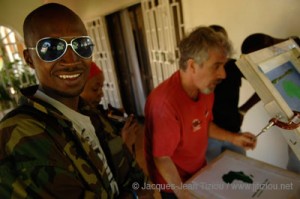 sometimes more than once. Lumber was an odyssey unto itself.
sometimes more than once. Lumber was an odyssey unto itself.
I came into these photos because our friend Doug Rori, in the camouflage jacket, is working with us on a new Indiegogo campaign to fund his work with A Well-Fed Kenya. (More on A Well-Fed Kenya in upcoming posts!) I asked him for pictures of the two of them together, to help tell the story of our collaboration.
I love that what he found were pictures of the silkscreen workshop. C.T. had told me the story several times and it captures my imagination to realize the ways we can take our power back. If we can mass produce our own newspapers, t-shirts, posters, etc., with found materials, then we control our message, we own our stories. This is the profound power of the silkscreen press workshop, like all the others during the IndyMedia Convergence.
[Activists in Mexico made entire copies of C.T.'s book, Food Not Bombs: How to Feed the Hungry and Build Community, in Spanish, on a silkscreen press. His copy is one of his treasured possessions!]
The students and C.T. made a press that day. And today Doug and I will launch our Indiegogo campaign to get the message out about a really amazing, holistic project that feeds many people and teaches them the skills of getting their own messages out every day. Stay tuned!
Life in the Parking Lane
No matter how you toil, no matter that you seek to serve, there comes a day when you wake up and realize: You’re living in a fucking driveway.
Wait, that’s just me.
Somehow, when we had our rv parked on larger parcels, I didn’t experience self consciousness about living in a dumbed down Star Trek shuttle craft. But now that I’m sandwiched between two houses, parked in my friend’s driveway, where a neighbor could look out their window and into mine, well, I feel a bit like that extra passenger riding the stick shift in a compact pickup.
I nearly have to hold my arms up to squeeze through the gate past the back of my rv Serenity, to go between the front and back yard.
And when my host wants to mow the front lawn, we have to lift the battery-powered mower high through the same passage.
 Today I realized that, to retrieve my camping gear, located in a lower compartment with its access door on the outside of the rv, I’m going to have to take Serenity off her hydraulic lifts and back her up several feet, then drive her back in position!
Today I realized that, to retrieve my camping gear, located in a lower compartment with its access door on the outside of the rv, I’m going to have to take Serenity off her hydraulic lifts and back her up several feet, then drive her back in position!
Imagine if you had to roll your entire house down the driveway ten feet to get into your attic or basement!
To keep some perspective, remember that rv’ing is just a form of camping. And when camping, tent or otherwise, everything takes longer, with strange extra steps, or an activity is just longer because it’s awkward—trying to put your pants on in a tent while wondering if there are bears. [Yes, there are bears. Are they near you tent? I don't know. Your shirt is on inside out...]
But complaining that my particular circumstance isn’t quite right is a pastime with me. It’s not my dominant experience.
Generally, I am really enjoying our time here in Silver Spring, Maryland. Our hosts’ backyard leads to a park with trails, soccer fields and lots of places for Tuatha and me to explore. Five kids with a soccer ball wore him out yesterday, much to his delight.
 Tuatha and I also take extensive walks through the neighborhood. I’ve gotten used to urban/suburban living and almost never forget to bring a plastic bag anymore. The waste of dedicating an entire plastic bag to a few little pieces of Tuatha poo used to grind my gizzard. Now I’m glad I remembered and can prevent some neighbor’s annoying discovery. I’m Wren Good Citizen!
Tuatha and I also take extensive walks through the neighborhood. I’ve gotten used to urban/suburban living and almost never forget to bring a plastic bag anymore. The waste of dedicating an entire plastic bag to a few little pieces of Tuatha poo used to grind my gizzard. Now I’m glad I remembered and can prevent some neighbor’s annoying discovery. I’m Wren Good Citizen!
Back to complaining then:
I’ve been boondocking here without my partner C.T. for a couple of weeks. He’s been dancing, politicking, volunteering and generally huffing and puffing at Dance New England in New Hampshire.
While he’s been gone, I’ve had trouble keeping the house battery charged and I appear to have run out of propane, which means no more fridge. Fun Fun. Thanks to my saintly patient hosts, my cold food is now in the house. We’ll get more propane next week.
Ants continue to find their way in, but as long as they’re not in the bed, we’ve made a livable deal: Some of them can stay, I’ll continue to be lazy about wiping my counters and sometimes I’ll squash large numbers of them with a napkin when I want to use the kitchenette as an office. Okay, livable for me…
Tomorrow I’ll host my first overnight guest here in the driveway. Visitors are always surprised at Serenity’s great size and expansive interior. When they see the galley, closets and bathroom they always remark, “It’s just like a house!”
Mission accomplished. It is a motorhome…Maybe they were picturing a Chevy van with a mattress and some granola in the back.
Heathcote had an old trailer that was home to many members through the years. It was no bigger than Serenity. Maybe if C.T. and I find land to live in Intentional Community again, Serenity will continue to house people for years to come.
In the meantime, we’ll get that battery issue handled, refill the propane tank, get her all past her safety inspection and registration…C.T. plans to drive her down to Louisa, Virginia for the Communities Conference at Twin Oaks over Labor Day weekend. While he and Serenity are traveling and teaching, I’ll be working with my friends from Crystal Cottage at the Maryland State Fair!
Then, after our various toiling and serving, it’s back to the driveway, plastic poo bags and suburbia!
Toys in the Attic: Wren Digs out More Perks for Indiegogo Campaign
I am certainly learning a lot about crowdfunding from our first Indiegogo campaign. We must interact daily with the site and potential contributors. Just like an offline campaign, we make daily phone calls and send out batches of emails and Facebook posts.
One fun addition is that, like Kickstarter, Indiegogo has us offer perks at a variety of levels for funders to choose. About half choose a perk, half skip that.
It is important to me to continue to read advice blogs from Indiegogo and to browse other campaigns, to learn what works and what doesn’t.
About midway through our campaign, I realized I could make much better use of the inventory of jewelry and gifts that I have left over from my shopkeeper days.
If you’ve known me or Hippie Chick Diaries long, you know I used to sell gemstones, figurines, incense, batiks, musical instruments, etc., and jewelry I made myself in a traveling shop called Heathcote Earthings.
I had to give that up more abruptly than planned because of increasing problems with arthritis and anemia. That abrupt end left me with lots and lots of remaining inventory.
I would love to sell the entire lot to an existing store or someone wanting to get into the festival vendor business. I have listed the business several times online, including EZUp canopies, tables, covers and displays. But times are tough all over and I haven’t found a buyer.
In the meantime, my inventory really saved the day on Staten Island, where I was able to set up outside Every Thing Goes Clothing, thanks to Peggy and my other
friends at Ganas Community. Ganas operates several stores in the St. George area of Staten Island and ETG Clothing is right on the path to the Staten Island Ferry into Manhattan, so I had lots of foot traffic. I was able to raise much needed funds to move us down to Washington, DC.
Now I realize I can offer more of my inventory as perks in our current campaign. We’re limited to twelve perks per campaign. So I selected the
items pictured in this blog post for the current campaign. Click on each item for a more detailed description. (Clicking will take you to the main campaign page and perks are listed down the right side. These same pictures are repeated in the campaign’s photo gallery.)
Most of the pewter is lead free, diamond etched and made in Colorado. The batiks are handmade on rayon, a natural fiber and are designed by the artist Amara Wahaba Karuna, who is based in Hawaii.
What I love about being able to offer store items is that your contribution is a form of double gifting:
• First you make a donation to our cause (keeping our rv on the road so we can continue to offer Value-Based-Consensus workshops).
• Then you get a nice ethically made or fair trade item to give as a gift. Many people collect these motifs, which is why I stocked many frogs, dragons, cats, unicorns, bears, etc. Do you know such a collector? Maybe it’s you!
I don’t collect trinkets these days, but when I did, I collected folk art decoy ducks, interesting gemstones and Blenko glass. I also seemed to have collected sheltie and pygmy goat items to celebrate my four-legged family members.
I also seem to have a fun affinity with frogs, or their shape.
But isn’t this all just empty materialism? Yes. No argument. Even when you buy locally or fair trade. When a person in my shop would seem to agonize over a purchase, when I could tell that they loved the object but probably shouldn’t spend money on it, I would always tell them,
“There’s nothing in this booth that’s going to change anyone’s life. It’s all just a smile for awhile…”
In the early days of my store, I focused on the educational mission of the Heathcote Earthings project. If people were going to buy trinkets and gifts anyway, they should buy them from me or another ethical trader. Is it made of natural or recycled materials? Is it local or fair trade? Any slavery or environmental abuse involved? I enjoyed helping people to learn to ask the right questions, beyond, “Is this the cheapest?”
Toward the end of my time running the business, I grew impatient with peoples’ materialism and selling trinkets, however ethical their origin, was not meaningful enough for me. I began my shift into my current work in social technology.
I could look around Hina Hanta, my little hut in the woods at Heathcote Community and notice my own collections. Even though I didn’t have much, none of the objects around me was enriching my life. I came to imagine my life would be just as rich if they all disappeared.
I’ve written several times here about my thought that if my little house burned down, as long as I got my pets out, my quality of life would be little changed.
Now, my family lived through a devastating fire on Valentine’s Day of my eighteenth or nineteenth year. So I know that much is lost in a fire that does matter—family photos, everyday clothes, legal documents, heirlooms. And I do know that there’s a mourning after a fire.
But still, I looked around at what I collected and I knew I could live without nearly all of it.
And so I have.
When we left Hina Hanta to live aboard Serenity, I had to be selective about what I could bring. Nothing too heavy, nothing breakable, nothing useless. I’ve lived six months and counting without my dust collectors and my quality of life is not diminished by their absence. In fact, it’s easier because I don’t have to care for them. Even the one folk are decoy I brought with me took a tumble going down the road and is now decapitated. Them’s the breaks…
(But rv life has its own material requirements. After years of getting plastic out of my life for ethical reasons, suddenly I chose plastic storage containers, etc., for pragmatic considerations.)
So what does all of this mean for the Indiegogo campaign and choosing one of these only-slightly-less-evil-than-most material objects?
Hey, it already exists. And it’s still a smile for a while. And we’re human. We love and we’re going to keep giving gifts, even to ourselves, even if we do become more selective about it.
I hope if one of these perks speaks to you you will enjoy treating yourself or someone else. And C.T. and I deeply appreciate the support of each and every contribution, large and small.
Thank you for all you do in the world! 
—WT
P.S., Please visit our Indiegogo campaign! We’re raising funds to get Serenity, our motorhome, all registered and passed by the Maryland State Safety inspectors. See lots of perks for donating and pictures in our gallery:
Occupantless: More Vacant Homes than Homeless Americans
 There are various posters cycling through my Facebook newsfeed that tell me there are more empty houses in the U.S. than there are Americans who need homes.
There are various posters cycling through my Facebook newsfeed that tell me there are more empty houses in the U.S. than there are Americans who need homes.
In a quick fact check on Google, I find out that, according to truthdig.com, Amnesty International USA puts the statistic at five vacant houses per homeless person.
I am exploring my very personal relationship to this information. Since February of 2012, my partner and I have been on the road and, in fact, homeless. The short version of the story is that, while we were touring Occupy in November of 2011, our Intentional Community was dealing with zoning complaints by a neighbor. Instead of having a long, expensive legal process, the community decided to voluntarily, pre-emptively condemn several houses, including mine. Given that we were committed to our tour and that we had ongoing philosophical differences with some of our community mates, C.T. and I decided not to fight the decision, but to leave the community where I had lived and taught for sixteen and a half years.
 Since then, we’ve been traveling in Serenity, the rv we bought through donations and loans. And we’ve often stayed for extended periods with friends and supporters of our consensus work. There are two very different ways to view our experience of homelessness so far:
Since then, we’ve been traveling in Serenity, the rv we bought through donations and loans. And we’ve often stayed for extended periods with friends and supporters of our consensus work. There are two very different ways to view our experience of homelessness so far:
1) We are totally privileged. We have enough food, usually similar to what we ate in community. We’ve never slept on the street or in a shelter. We are able to have our dog with us. People donate to our expenses because of our status as consensus trainers. We
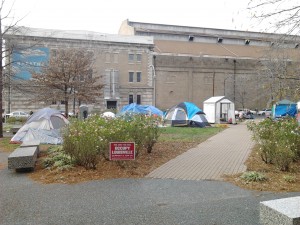
Occupy Louisville encampment, populated entirely by homeless people when we visited in November, 2011.
continue to find enough money to keep our phones on, and we usually have internet access. No one would compare our experience to the common idea of homelessness.
2) Homelessness in not a cliff one drops off of, but rather a sliding slope. Many of the homeless people we met in Occupy encampments told similar stories to that of my birth father, who spent the last nineteen years of his life on the street. At first he had a home but got behind financially. He left in the night without a word and began a period of years in which he stayed with friends and relatives, eventually wearing out his welcome until he was relegated to the streets. He received SSI for post-polio syndrome and traveled between tent villages in the warmer states. When he died on the street in L.A.’s Mission District he was fifty-three. His family hadn’t heard from him in over a dozen years.
I don’t expect to repeat my father’s story. But without a regular home and address, everything gets complicated—getting mail, getting a job, etc. And many things are more expensive. I have a small kitchen on board Serenity but in community, I ate from bulk supplies, bought at wholesale. If I were on the street, the story would slide down the slope quite a bit more.
And what about that Amnesty International statistic?
 Right now, C.T. and I have parked our rv in the driveway of a friend in a DC suburb. It’s a middle class neighborhood quickly becoming working class as the economy worsens. Just a few doors down from me, surrounded by houses that are valued at at least $150,000, is an abandoned house. It’s a split level on a huge lot backing up to a park. The grass is three feet high. Several mature trees have fallen and no one has removed them. Some gutters have plants growing in them, others are angling down. The roof itself is sprouting greenery. In the back yard, people from the park have made paths to cut through to the neighborhood.
Right now, C.T. and I have parked our rv in the driveway of a friend in a DC suburb. It’s a middle class neighborhood quickly becoming working class as the economy worsens. Just a few doors down from me, surrounded by houses that are valued at at least $150,000, is an abandoned house. It’s a split level on a huge lot backing up to a park. The grass is three feet high. Several mature trees have fallen and no one has removed them. Some gutters have plants growing in them, others are angling down. The roof itself is sprouting greenery. In the back yard, people from the park have made paths to cut through to the neighborhood.
It’s such a sharp contrast to the manicured lawns on either side. Is it a foreclosure? How long has it been abandoned? I have to admit, I’ve had my squatting fantasies. It’s hard to see a roomy, nice house go to waste while I am driveway hopping.
 Starting in Baltimore, which has an amazing number of vacant homes. we started to hear talk among Occupy activists of occupying vacant homes. From his early activist days, C.T. has had some experience with successfully occupying vacant property. There are ways to go about it, knowing you’ll be evicted, in order to make a statement. And there are different ways to go about it if you actually want to hold onto your squat for an extended time.
Starting in Baltimore, which has an amazing number of vacant homes. we started to hear talk among Occupy activists of occupying vacant homes. From his early activist days, C.T. has had some experience with successfully occupying vacant property. There are ways to go about it, knowing you’ll be evicted, in order to make a statement. And there are different ways to go about it if you actually want to hold onto your squat for an extended time.
What are the chances that we could find and occupy a vacant home? I don’t know. But every day, when I walk my dog past that abandoned house, I’m struck by the wasted resource, a building that some bank or landlord is hoarding. Or maybe that man owned it outright and just walked away for some reason. I don’t know. But I’m becoming curious enough to investigate.
Anyone out there want to squat?
—WT
P.S., Please visit our Indiegogo campaign! We’re raising funds to get Serenity, our motorhome, all registered and passed by the Maryland State Safety inspectors. See lots of perks for donating and pictures in our gallery:
Cue the Pink Panther Theme Song: Dead Ant, Dead Ant, Dead Ant….
I’m distracted by wondering how “dead ant, dead ant…” originally got associated with the theme song to The Pink Panther. Can anyone remember?
Anyway, I’m enjoying the distraction because I’ve spent several days building up muy & mucho bad karma by vacuuming up tiny ants in the rv.
I originally ignored the few that came at first. Then I investigated around the tires and hydraulic lifts of the motorhome and I thought I found how they were getting in.
Since I’m not back at Heathcote Community with my preferred herbs and powders for repelling them, I accepted our host’s offer of Raid, which I applied liberally (meaning well intentioned, making myself feel better but never seeing the whole picture and not really changing anything). But spraying Raid didn’t even slow the ever increasing trails of little black ants.
I remembered that at Heathcote, both in the springhouse where I first lived, and later at Hina Hanta, I had major ant events, beyond what my alternative knowledge could handle. Since Heathcote has a prohibition against insecticides in our land lease, I tried vacuuming them over several days.
It totally did the trick. That sucks.
You see, I am one of those unapologetic animal rights types who identifies with Bambi and doesn’t want to hurt a flea. So it wasn’t lightly that I took this step.
And the entire time that I pointed my suction want of death at row after cluster of scattering ants, I imagined a giant sucker lowering from space, gulping up humans as if we were fodder in a very sick video game.
I remembered Henry David Thoreau’s essay on watching ants at work under a tree at Walden Pond. He marveled at their industry. I wondered what I don’t know about ants and what it is like to be one as I watched them appear and disappear.
I guess I’ll find out in my next life, because I’ve totally committed ant genocide now. Trouble is, it worked again. This callous behavior has been reinforced again.
I remembered the scene in the movie Contact, where characters are discussing whether or not to trust technologically superior aliens. They compare aliens to humans killing ants, and noting that we don’t feel badly for long afterwards. And I notice that I don’t. Ants are not beings I identify with strongly, despite momentary curiosity about ant life and ongoing respect for their collective focus.
Sometimes nature is cooperation. Sometimes it is competition. My motorhome. Ants enter at your own risk.
I’ll see you next time around the wheel. Please don’t vacuum me…
—WT
Please visit our Indiegogo campaign! We’re raising funds to get Serenity, our motorhome, all registered and passed by the Maryland State Safety inspectors. See lots of perks for donating and pictures in our gallery:
Why Is a Dog Driving?
 People might think it’s flippant or cute that we wrote our Indiegogo fundraising campaign in the voice of our dog. But for us, that’s a perfect representation of his membership in our collective.
People might think it’s flippant or cute that we wrote our Indiegogo fundraising campaign in the voice of our dog. But for us, that’s a perfect representation of his membership in our collective.
Tuatha’s safety and security (and his place in our lives) are big reasons for our choice to travel by rv. Another is my desire to have a sense of rootedness. Whereas C.T. is a true gypsy, happy living out of a suitcase perpetually, I come from rooted people and prefer a sense of home.
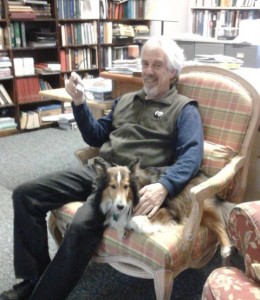 Tuatha is both a child of ours and a sage teacher, grounding us in what’s important while bringing rhythm and routine to our lives. He’s a clown, an athlete, a doorbell and a cuddle buddy.
Tuatha is both a child of ours and a sage teacher, grounding us in what’s important while bringing rhythm and routine to our lives. He’s a clown, an athlete, a doorbell and a cuddle buddy.
When C.T. first met my dog Tuatha, he said, “That’s not a real dog,” remembering is old lab Yoda, who was not as pampered, nervous and needy as Tuatha. But as they taught each other how to play soccer and as vegetarian chef C.T. took over the chore of cooking Tuatha’s vegan dog food, they each came to their own understanding. C.T. decided that Tuatha is in fact a dog, of a sort, and also a child substitute, and Tuatha claimed C.T. as his Papa.
As we park Serenity in our fourth host location since leaving Heathcote in February, Tuatha feels secure with all the changes because we’re there, we’re family. And he has the same effect on us.
Fiopa is not the first collective to be shaped by the needs of a dog. There’s the tale of a set of puppies that cemented the collective that would create Food Not Bombs.
Stay tuned to Hippie Chick Diaries for the story of the dogs that founded Food Not Bombs!
In the meantime, please visit our campaign, contribute and refer friends often. We have about three weeks left to raise three thousand dollars and keep our rv home on the road!
Since our campaign started, C.T. and I have received no fewer than four requests for workshops. But none of these new groups have funding to hire us. Let’s show the world what community means by keeping this consensus teaching going!
Loaves and fishes, my friends; Loaves and fishes!
—WT
Please join our Hippie Chick Diaries fan page on facebook!




